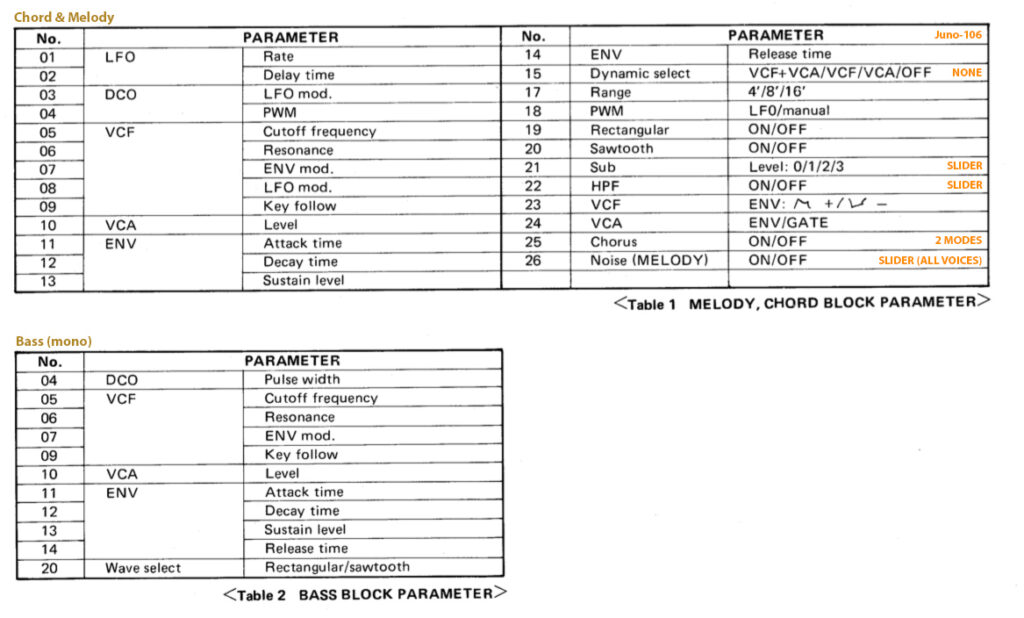This page compares the Roland MKS-7 to the Roland Juno-106. To understand it, you need to know the Juno-106. Some people say the MKS-7 is the rack version of Juno-106. But it’s more… and less.

The Roland MKS-7 was allegedly intended for MIDI-file playback and karaoke, thus being a consumer market product. The voicing hardware is similar, but not identical, to the Juno-106.

Background
A Roland MKS-7 could be considered a more affordable, yet in some respects more capable, version of the Juno-106.
The MKS-7 has a somewhat complicated scheme of three different voice types. It is in a way a multi-timbral synth, but there are more restrictions than what you might be used to.
- Two voices are assigned to Melody functions
- Four voices are assigned to Chord functions
- One voice is Bass
- There is a drum kit based on the Roland TR-707
According to one of my customers, the MKS-7 can be set in “Juno-106 mode” and so the six first voices behave like one Juno-106. I have not tried it, and I have not researched it either.
Juno-106 advantages
- Sliders and buttons for every patch parameter
- User patch storage
- No restrictions on how to use the 6 voices – simple
MKS-7 advantages
- Velocity control of filter and VCA
- Lower second hand price than Juno-106
- More voices – 6 poly voices, plus one dedicated bass voice, plus drum sounds
- Multitimbrality, to some extent
Here are the parameter differences between the two. The tables are from the MKS-7 service manual, with Juno-106 specifics noted in orange. My notes follow after the image.

So what’s specific for the MKS-7?
- Dynamic select (aka velocity control of VCA Level and / or Filter Cutoff) – Yeah baby! This is a big thing. The Juno-106 lacks any type of velocity sensitivity, which is one of its biggest weakness.
- Sub OSC level in 4 steps instead of the Juno’s slider – Seriously, this wouldn’t make much of a difference.
- High Pass Filter is ON/OFF instead of a slider – Personally I don’t think this damages patch creation much, but if you use HPF a lot it could be a problem.
- Chorus, only one mode – This is a problem. A lot of the dreamy character of some Juno-106 pads and strings come from Chorus II. The MKS-7 only uses one BBD chip, compared to the Juno’s dual MN3009.
- Noise – Noise is only available on the two Melody voices, and even so it’s only available at full volume or nothing. Some people like to add a bit of grit to a sound with a little noise.
The Bass voice
The bass voice differs from the ordinary voices in many respects. It has no modulation at all except envelope. It can switch between saw and pulse waveforms, but can’t have both at the same time. There’s no noise, no inverse envelope, no HPF etc. On the plus side, the Bass has an analog envelope. This is important because the control voltage it outputs has an exponential shape, and therefore has more punch with shorter attack- and decay settings. All things considered, this bass voice is a lot more trimmed-down than any Roland bass synth, like SH-101 or SH-09. Since it lacks velocity sensitivity I dare say it’s even more basic than the TB-303 sound engine which sports accent and slide controls. Still, it’s a rock solid bass, and a lot of people like it.
Creating patches and saving them
The MKS-7 comes with 100 chord / melody presets and 20 bass presets. They can be edited using SysEx, but they cannot be saved inside the MKS-7. It doesn’t even remember what patch you selected for Chord, Melody or Bass once you turn it off.
A software SysEx editor, or DAW plugin, can be used to edit the MKS-7 parameters, and that software could also save your custom patches. You would have to upload the patches to the MKS-7 every time you restart it.
But everybody ideally wants hardware sliders and buttons. You could get a Stereoping Juno-106 programmer or a Behringer BCR for that. But doing so, you will still have to save your SysEx patch in your sequencer, in a SysEx librarian, or within your programmer if it allows that (Behringer BCR does not).
Conclusion
Using the MKS-7 to get a Juno-106 is a bit too much hassle for me. What still makes me consider it is the price difference from 106 and that the MKS is velocity sensitive. I’ll stay with the JU-06 for now.